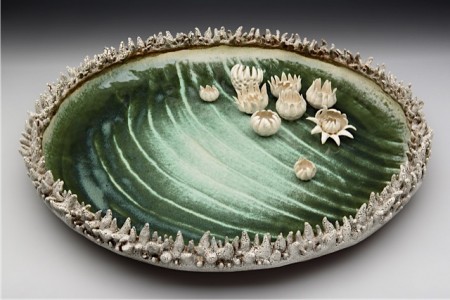The thesis of “Vestiges” is set out on the announcement card: “. . . Brenda Tarbell, Cheryl Pannabecker, and Carrie Pate explore the natural world and relationships, bringing to the surface the unnoticed, hidden, or unexpressed.”
There was something about the exhibition title that seemed off to me so I went to the dictionary. “Vestige” is defined as “a trace, mark, or visible sign left by something (as an ancient city or a condition or practice) vanished or lost.”
That bolstered my conviction that the works on view weren’t “vestiges” of anything. Tarbell’s fantastical ceramic creatures and vegetation are unearthly, Pannabecker’s clay wall pieces present landscapes of a darker world, and Pate’s dreamy figurative paintings belong to another dimension; they are not shadows of anything.

Cheryl Pannabecker’s works look like oversized brooches with loopy misshapen (think George Ohr) “frames,” for the lack of a better word. She’s painted her convex forms with slips and glazes for the look of shiny enamel, reinforcing the allusion to jewelry. With the low horizon lines of her landscapes, the noble trees, limned with more than a touch of Chinese ink-wash brushwork, are silhouetted against mottled turquoise or sickly yellow skies, clouds suggested by the modulated color.
Pannabecker’s least successful pieces have figures. Some are merely suggested by daubs of white, as in By the River, and are incidental to the scene. When they are larger, they are awkwardly drawn as can be seen in another work. A bluish-green figure dominates the foreground, fleeing a desolate landscape of parched earth and windblown trees. With hands covering her ears and open-mouthed visage, the pose is a dead ringer for Munch’s The Scream, which the artist openly acknowledges in the title: Calling Out. However, Pannabecker’s baby-doll-like figure does not convey the despair of Munch’s. Pannabecker’s pieces are best when they focus on the landscape, leaving the viewer the option of entering into it.

The figure plays a much more important role in ceramist and mixed-media artist Carrie Pate’s paintings. Her brushwork is free, even sketchy. Her backgrounds tend to be abstract and expressionistic while her figures are representational. In Scintillating her palette and handling of paint bring to mind Chagall, but the female’s full-length pose reminds me of John Singer Sargent’s Madame X. In both a woman dominates the composition. Pate’s wears a red sheath, not a dramatic black gown like Madam X does. Both are subtly twisted in contrabody poses although Sargent’s mysterious woman, who is the socialite Virginie Amélie Avegno Gautreau, turns her head away; Pate’s woman confronts the viewer although her feet are ready to carry her off the right.
Pate often collages elements onto the surface of her paintings. Here her butterflies and doves, favored motifs, and a bit of what looks like floral wallpaper are cut out and pasted on, but do not call attention to themselves. Alas, in Blinded, these additions aren’t discreet and do distract from the two figures, one occupying the upper-left quadrant and the other the lower right. The latter, with eyes closed, leans back as if sleeping or resting, perhaps representing how she is separated from the world by her blindness, creating her own reality. Her sighted counterpart gazes off, lost in her own world, perhaps as much a fabricated reality as her blind companion’s. Burlap patches scattered over the surface and the piece of string meandering off the top left edge assert themselves without adding to the aesthetics or meaning of the painting. Even worse are the ogival forms, presumably windows, cut out of the surface.
Pate redeems herself with Hush. On the far left and right edges of the elongated rectangular canvas, two women, who could be twins, are shown from the waist up and wear identical diaphanous and strapless gowns, one white and the other a watery turquoise. They float against an amorphous blue background; is it sky or water? They gaze into space, oblivious to the other even as they reach out in a pose cribbed from Michelangelo’s The Creation of Adam on the Sistine Chapel’s ceiling. The fingers of the twin on the right are extended, nearly like Adam’s, although she is in the position of God. The other’s hand is lost in a mist. I take the title as a noun describing the silence surrounding them, not a verb admonishing the women to remain quiet. It is the simplest painting in the show, but also the most affecting.

Brenda Tarbell’s sculptures made of paper clay (clay blended with a fiber such as cellulose) allude to nature, but don’t represent anything that I’ve experienced. She presents two types: spiky “Tentacled Forms” and delicate “Petal Forms.”

Two Tentacled Forms are installed side by side on a single pedestal. Menacing fang-like tentacles rim the openings of each of the dual-lobbed vessels. Are they mutant Venus flytraps or bizarre aquatic creatures? Are they strange pods that have burst open? Could they be creatures who propel themselves along on chubby legs? Are they poised to metamorphose into fauna from flora, or is it fauna to flora? Whatever they, they are destined to confound the scientist while they enrich our world.

Her “Petal Forms” are exquisite white blossoms and lovely although you could see the individual petals as kinder and gentler spikes. Several “float” in Tentacled Basin with Petal Forms, a flat birdbath-like vessel. She gives the impression of a ripple with her green-y glazes and very subtle surface, which has just barely, really barely, raised ribs that radiate out in a semicircle from the edge. Tarbell’s “Petal Forms” might be seen as stylized versions of our reality, but even so they are still fully realized products of her imagination.
Although the curator, Yvette Johnson-Hegge, YWCA executive coordinator, sees these artworks as vestiges, my mind insists that they exist fully formed in an alternative universe, a parallel plane, or another dimension.
–Karen S. Chambers
“Vestiges,” YWCA Women’s Art Gallery, 898 Walnut St., Cincinnati, OH 45202. (513) 241-7090, ywca.org. Through March 24, 2016.